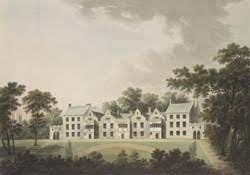
Anderson Place, Newcastle upon Tyne, situated within the city walls near the ruins of a Franciscan Friary, was built in the 16th century by Robert Anderson, and was also subsequently known as Newe House and then Grey Friars. Standing in extensive grounds covering twelve acres, with a tree lined avenue leading to the house, the gardens of beautiful walkways and greens extended down to the main entrance on Pilgrim Street. It was believed to be the largest privately owned house within the walls of any town or city in England.
King Charles I stayed at Newe House during his captivity in Newcastle (1646-1647) under General Leven, who later broke with parliament to support Charles II before being defeated by Oliver Cromwell’s army at Dunbar in 1650.
It was purchased in 1675 by Sir William Blackett (1621-1680) and renamed Grey Friars, and on his death passed to his younger son, another Sir William Blackett (1657-1705), who extended the house. Under the Will of the third Sir William Blackett (1690-1728) it then passed to Sir Walter Calverley Blackett (1707-1777) who married this Sir William’s illegitimate daughter, and finally to Sir Thomas Wentworth Blackett (1725-1792). After Sir Walter Blackett's death Grey Friars was offered for sale to the Corporation of Newcastle, but they declined, due to other commitments. In 1782 it was sold to Major Anderson (no known connection to the original Anderson who had bought it in the 16th century), who converted it into three residences, and whose son renamed the property Anderson Place in 1801. It was sold again to Richard Grainger in 1834. Grainger demolished it, and began his creation of what is now known as Grainger Town.

Situated near Old Eldon Square, and on the site of the old town walls formerly adjoining the north boundary of Grey Friars, Blackett Street was redeveloped in 1824, and subsequently extended, by Richard Grainger. Most modern references (including our own 'A History of the Blacketts') state that the street was named after John Erasmus Blackett (1729-1814). Our recent research has, however, indicated that this is unlikely, as the street had been known as Blacketts Lane/Blackett Street at least as far back as 1782. Please see The derivation of the name of Blackett Street, Newcastle for a detailed examination of the evidence.
Even if Blackett Street was not named after him, John Erasmus Blackett was an important figure in Newcastle. He was the father-in-law of Admiral Lord Collingwood (see Naval Blacketts), and for many years occupied the position of Chief Steward of the vast business empire of his wealthy Blackett cousins. He was also prominent in public life and was Mayor of Newcastle four times, in 1765, 1772, 1780 and 1790, and was one of the original partners of the Newcastle upon Tyne Fire Office, established in 1783, which now forms part of the Aviva group. According to his brother-in-law, the noted autobiographer Rev. Dr. Alexander Carlyle, “John Blackett was called Erasmus after Erasmus Lewis, who was secretary to Lord Oxford in Queen Anne’s time, and an intimate friend of his father’s, John Blackett of Yorkshire.”

Earl Grey’s monument, erected in 1836 to commemorate the passing of the Reform Act, stands at the head of Grey Street, Blackett Street, and Grainger Street.
